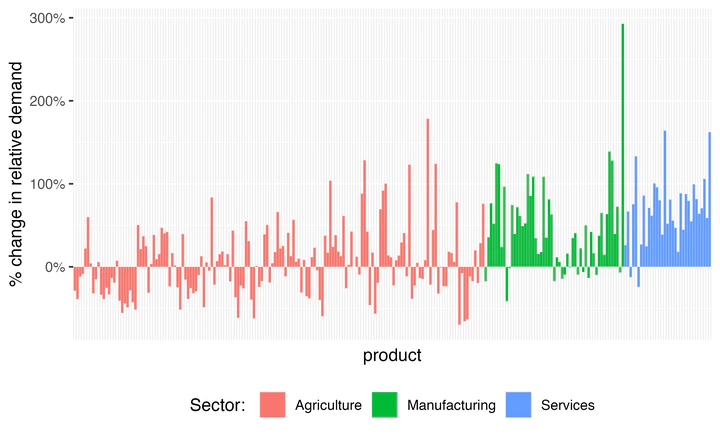Income Inequality and the Dynamics of Structural Change
 Predicted changes in demand
Predicted changes in demandIn my ongoing work on Income Inequality and the Dynamics of Structural Change, I study how demand changes over the course of development and how this affects industrialization and changes in the industrial structure of economies over time. For this, I draw on extensive Indian micro data, both at the household and worker level as well as the plant level.
I start by motivating the importance of income effects and income inequality in driving structural change (the reallocation of resources across broad sectors of the economy). Product-level or sector-level demand, by definition, is a function of the entire income and preference distribution as well as prices and quality across all products. Drawing on representative household-level consumption data, I show that simply taking demand at the product and sector level across the entire income distribution in 1987, but now feeding in the income distribution 25 years later (and thereby fixing prices, preferences and quality), explains about 60-80% of structural change out of agriculture and more than 100% of the structural change into manufacturing. These numbers are surprisingly close to recent structural papers that have tried to disentangle income from supply-side effects without accounting for and modeling household heterogeneity (e.g. Comin et al ‘21, Alder et al ‘22).
I show that observed demand heterogeneity over the entire income distribution is crucial not just to answer questions on the role of inequality in driving structural change and development, but also to disentangle mechanisms. In standard models of structural change, structural change is driven by a combination of endogenous income effects on the demand side and exogenous changes in technologies on the supply side. In this story, changes in technology induce economic growth that drives up income and feeds back into changes in demand, but demand changes do not affect technological change. To quantify the importance of dynamic demand effects on future technological change - a key mechanism in most models of endogenous growth such as learning-by-doing and purposeful investments in R&D - I link the previous exercise to changes in productivity at the plant-level. That is, I use changes in the income distribution over time to obtain heterogeneous demand shifters in the absence of any future changes in preferences, prices, productivity and quality. I then ask whether industries that - based on demand in 1987 - were expected to see differentially large increases in demand over time, also see differentially large increases in productivity. This exercise allows me to quantify the importance of dynamic productivity effects. At the moment, I am both finishing this quantification and building a structural model to account for Indian structural change since 1987.